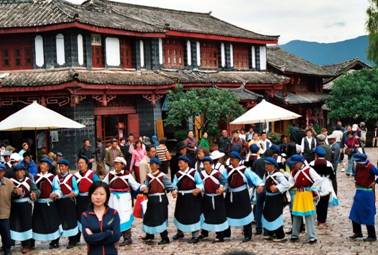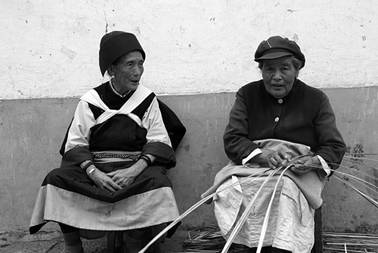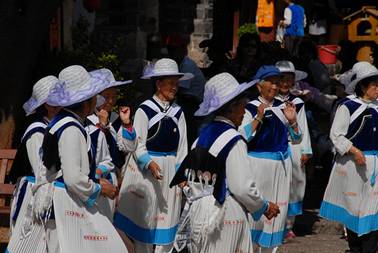The concept of “minority” in China is very different from what it is in America, England, or even Australia. The Western concept of minority generally includes anyone who isn’t of the majority, that is, people who are non-white and have non-European backgrounds. But in China, being a minority is something else entirely. Minorities in China are often indistinguishable from Han Chinese, despite the fact that they claim distinct history, culture, language and sometimes religion. Minorities make up only a tiny portion of China’s overall population, but they add a bit of diversity to an otherwise homogenous society. However, minorities often find themselves in a strange position in China, being thrust into certain roles, their difference serving what is considered a greater good. Westerners, with their hunger for everything “authentic” often have a hard time coming to terms with what it means being a minority in a Han world.

Photo: Luis Franco
Living in Yunnan as long as I did, I was witness to minorities on display practically every day. There are girls dressed in Bai clothing greeting you at restaurants, there is Dai hulusi music playing at the bird and flower market, and Wenlin Jie is lined with shops which would ply you with “silver” or Naxi leather. Minorities are a commodity in Yunnan, put on display for the consumption of tourists in a way that most Westerners found uncomfortable. Certain places could remind one someone uncomfortably of a truck stop along Route 66, selling “Indian” memorabilia, perhaps complete with a run-down petting zoo. Tacky. Fake. Disrespectful. Many a traveler to Lijiang, a tourist Mecca in the heart of Yunnan, has remarked that it’s almost like a Naxi Disney World, complete with nightly dances around a large bonfire in the main square, traditionally-garbed old Naxi ladies singing traditional Naxi songs as they hold your hand and show you the traditional dance steps. Lijiang has beautiful architecture and beautiful scenery, but the old town has nothing, absolutely nothing, besides shops and bars and restaurants. The old city exists as a tourist center, without tourism there would be no old town of Lijiang.

Photo: das farbamt
There is no doubt that minorities in China are blatantly objectified. It almost became a joke for those of us living in Yunnan long-term, for anytime there would be any sort of official function, inevitable we’d end up with a minority song and dance routine. Even now, watching CCTV in Beijing, I see children on Music Express, a talent show for youngsters, claiming to do a “minority” number. Rarely do they identify which minority they’re representing; it is simply some generic minority identity that exists to add a flair of the exotic to China’s otherwise homogenous existence. The objectification is not always completely innocent either. Just ask anyone who has visited Lugu Lake about the concept of “walking marriage.” “Walking Marriage” refers to the Mosuo people, a matrilineal society, and their practice of allowing a woman to share her bed with any man she wants, and the man is free to go in the morning. Nowadays Han tourists arrive at Lugu Lake in droves and actively seek out “walking marriages,” and Sichuanese or Guangdongese women dressed up in Mosuo costumes are happy to oblige. A Mosuo custom, as well as China’s only matrilineal society, reduced to a clever cover for prostitution, and a convenient excuse for Han males who are quick to buy into the myth that the exotic minority women are eager and willing to please. Objectification of minority cultures does, sometimes, take a more sinister turn.

Naxi women, Photo: Ed-meister
That said, as a student in 2003 I traveled to Zhongdian, which has now been renamed Shangri-la, with my classmates, and on our way back from a Monastery we saw a Tibetan family dressed in traditional Tibetan outfits, standing in front of some forlorn looking Yaks and offering pictures to passing visitors, 10RMB a pop. One of my classmates remarked “How disgusting! How can they pimp out their own culture like that?” And I thought silently to myself, yes, but should they have to go back to herding, making probably less than 50 dollars a month, because we think it would be more “authentic?” Who are we to tell these people they can’t make a buck off their Minority-ness just because we want something a bit closer to Paradise Lost. There is something almost Orientalist about the Western travelers almost obsession with finding real, live, minority peoples. The sad reality is that often even when we do find minorities in their “native state,” the picture isn’t always that pretty. The minority areas of Yunnan are some of the poorest in China, children have low levels of education, and minority culture itself is on the decline. Although the song and dance troupes may be a bit cheesy, they serve an important purpose too, they preserve cultures that are often in danger of dying out. While we marvel at approaching a Dulong village after a long trek, finding a grandmotherly figure who still wears traditional minority clothing and speaks absolutely no Chinese but is still willing to offer you a roof and a hot meal, it is impossible not to look at her children and grandchildren and wonder what will become of them.

Photo: das farbamt
I myself often find that I am torn between wanting cultures to stay, preserved at some innocent time pre-Wal-Mart and Wendy’s, and acknowledging, as I eventually must, that it is not my choice to make. While we decry Lijiang as a Naxi Disney Land, what would Lijiang be without tourist dollars? It would likely have been leveled long ago to make room for yet another high rise or stadium. Isn’t the fact that Lijiang still exists, that the canals still run through the city, that the old style architecture is still on display for you and I to see, something positive rather than negative? While the line between preservation and exploitation sometimes runs dangerously thin, isn’t the former something to praise when it does happen, rather than being upset that the preservation is not to our liking? After all, we live, all of us, even the Naxi and the Dai and the Dulong, in an increasingly modern world, and the fact that these cultures have remained distinct at all, after thousands of years of interaction with the Han, after Revolution, Reform, and well into the 21st century, is something of a miracle. The West, after all, has not done quite so well with its native cultures. The minority issue is complex, and there are many many arguments on both sides, arguments that make sense, that are well thought out and well-researched, but in the end, China’s minorities are at least still alive to sing the songs and dance the dances, and so I give credit where credit is due.
***
Expat Corner > Knot a Problem – China’s Lhoba Minority
China Explorer > A Brush with the Miao: Exploring South East Guizhou
China Media > Chinese Feminism? No Thank you!
Warning:The use of any news and articles published on eChinacities.com without written permission from eChinacities.com constitutes copyright infringement, and legal action can be taken.
All comments are subject to moderation by eChinacities.com staff. Because we wish to encourage healthy and productive dialogue we ask that all comments remain polite, free of profanity or name calling, and relevant to the original post and subsequent discussion. Comments will not be deleted because of the viewpoints they express, only if the mode of expression itself is inappropriate.
Please login to add a comment. Click here to login immediately.